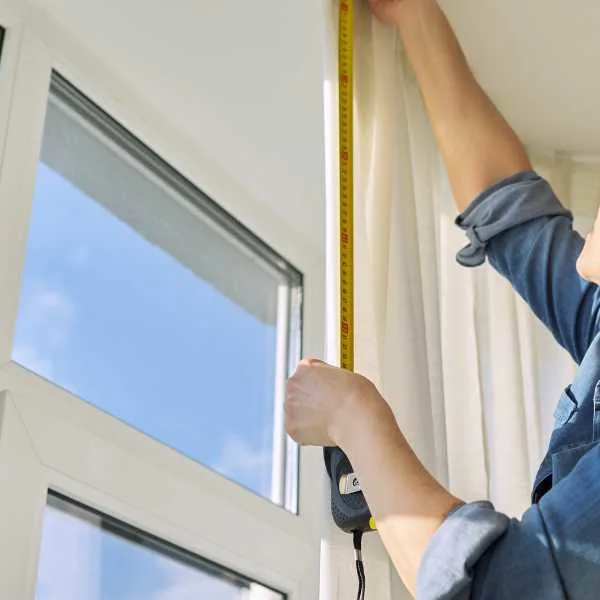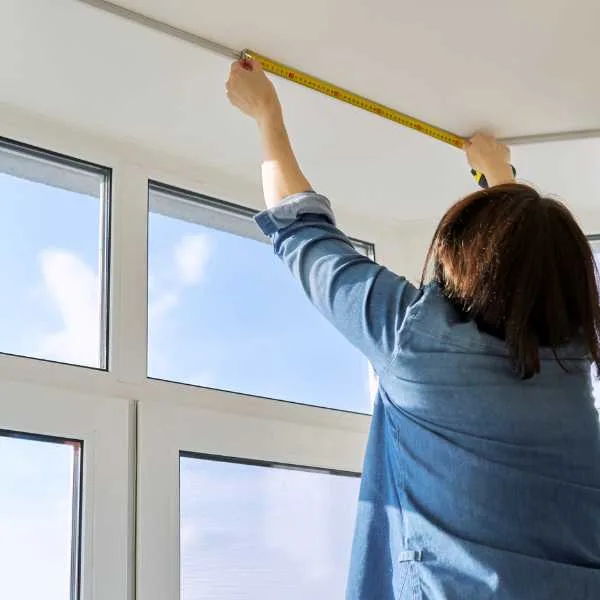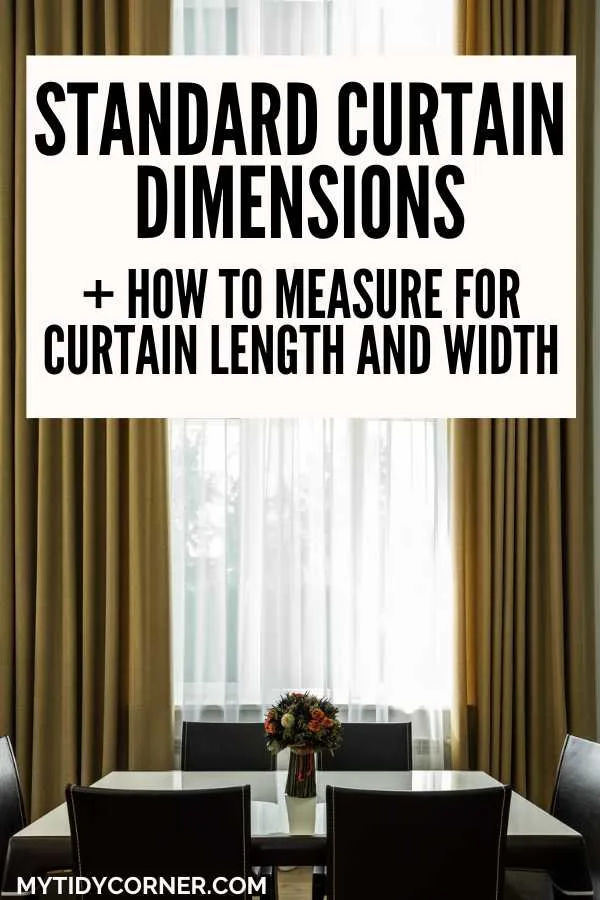Curtain Size Guide: Choosing the Right Drape Dimensions for Your Home
Find out the standard curtain sizes, plus tips on how to measure for curtains to help you make an informed choice.
I’ve lived in plenty of rentals, from student dorms to oddly shaped rooms in shared accommodation and, later, my first tiny apartment. You don’t want – or have the cash – to splurge on fancy drapes, so standard curtains are your go-to.
Even if they’re a short-term fix, you want your curtains to fit well, so measuring and sizing are important. Let’s look at the standard curtain sizes and dimensions.
The standard curtain sizes or dimensions are expressed as width x length. The width means the curtain rod between finials, which is the width of a single curtain. The length is the measurement from the curtain rod to the window sill or floor. A standard floor-length curtain is 46″ x 96″.
Having drapes custom-made is a pricey option, so it’s handy to know that you can purchase ready-made curtains in standard sizes. It’s just a matter of measuring your windows, finding the matching size, and making alterations. What are the standard sizes and dimensions for curtains?

Related Articles:
Standard Curtain Dimensions + How to Measure a Window for Curtains
For convenience, curtains are ready-made in standard sizes to fit most contemporary, mass-produced window frames.
Curtain dimensions are expressed as w x l, so you’ll find curtains of 46 x 63, meaning a curtain panel is 46 inches wide and 63 inches long.
Standard Curtain Lengths
The length of a curtain is often called the drop. Depending on the length of your windows, curtains come in the following lengths in the US:
- 63″ (160cm)
- 84″ (214cm)
- 96″ (244cm)
- 108″ (274cm)
- 120″ (105cm)
Standard lengths in metric sizes differ slightly, so you’ll find these lengths in the UK:
- 137cm (54″)
- 182cm (72″)
- 228/230cm (90″)
- 274cm (108″)
- 300cm (118″)
Standard Curtain Widths
In the US, standard curtain widths are:
- 46″ (118cm)
- 66″ (168cm)
- 90” (228cm – often 230cm in UK)
- 132″ (335cm)
How to Measure for Curtains
Before you purchase or order curtains, you need to measure your windows to determine the size and dimensions you need. You then need to translate these sizes from window to curtain dimensions.
The key to well-fitting curtains is accurate measurement. Make sure you start with the right tools:
- A steel tape measure that can’t stretch or fold and result in incorrect measurements
- A step ladder to reach the top of the window
- A place to record the measurements.
Always take multiple measurements along the window, as floors and ceilings are not always level or parallel.
How to Measure for Curtain Length

Curtain length is measured from the curtain rod or pole to the window sill or floor, depending on how long you want the curtains.
You, therefore, need to fit your poles and tracks before you measure, which means deciding on how high you want the curtains to hang. You also need to decide what header your curtain will have, as this will influence your measurements.
Measuring Length from a Regular Curtain Rod
If you have a regular or eyelet curtain rod, start your measurement from the eyelet on the bottom of the ring – this is where you insert the hook.
If you want the curtain to cover the ring, especially if you do not include a valance, add 1″ (2.54cm) to the measurement. You could also measure from the top of the pole to get a similar length.
Measuring Length from a Regular Curtain Track
For curtain tracks, you will start your measurement from the top of the curtain track.
Measuring Length for Sill-Length Curtains
For sill-length curtains, measure from the curtain rod (as above) to ½” (1.5cm) above the window sill. If there is a radiator under the window, ensure that the curtain stops 3/5-1 1/5″ (2-3cm) above it to avoid blocking the heat.
Measuring Length for Floor-Length Curtains
Measure from the curtain rod or track to ½” (1.5cm) above the floor for standard curtains that “float” rather than touch the floor.
How to Measure for Curtain Width

Measure the window’s width once you have decided on and measured for curtain length. You will want your curtains to cover the entire window width if you plan to close them. For decorative panels, blinds, and shades, you measure differently.
Here is how to measure window width for curtains or drapes.
Measuring for Width without a Curtain Rod
If there isn’t a curtain rod, pole, or track in place, you need to measure for and install one before determining the width of the curtains.
- Measure the window’s width from the frame’s outer edges or trim.
- If you want to position the rod above the window’s trim, add 3″ (7.6cm) to the measurement to get the width of the rod.
- Add 3-5″ (7.6-13cm) to the measurement for a rod below the window trim.
- If you want a more dramatic window treatment, extend the measurement of the curtain pole by 6-8 inches (15-20cm).
- Once you’ve installed the rod, continue with the measurement below.
Measuring for Width with a Curtain Rod
If there is already a curtain pole or track properly installed, you can base your measurements for curtains on that.
- Measure the full width of the pole or track from end to end.
- Do not include the finials at each end if your rod includes them.
- Add 1-2″ (2.5-5cm) to the measurement for ease and overlap.
How Long Should My Curtains Be?

Once you have done your measurements, you can decide how long your curtains will be.
What Style of Curtains Do I Want?
Begin by deciding what length of curtains appeals to you. Even if you are purchasing ready-made curtains, you can get a variety of curtain styles:
- Sill-Length Curtains: This length is appropriate for kitchens or bathrooms, especially when you have a window above a sink or cupboard. You will have measured for this length and taken the radiator placement into account.
- Apron-Length Curtains: This length reaches below the window sill but not to the floor. This is a useful length if you have a piece of furniture below the curtains. For this length, add 4-6″ (15-25cm) to your measurement for sill-length curtains.
- Floor-Length Curtains: These are the most popular and timeless of draperies, usually finishing just above the floor. However, if you want your curtains to graze or break on the floor, add 1-3″ (2.5-8cm) to the rod-to-floor measurement.
- Puddling Curtains: Add 6-12″ (15-30cm) to the floating length for a luxurious curtain puddle in a formal dining room or living room. Remember that this length does make curtains trickier to open and close and tends to collect dust and pet hair.
What Length of Curtain Do I Need?
Once you have the final measurement, round the measurement off to the closest standard length. The rule of thumb is always to choose a longer curtain so that you can alter it to fit. It is a real challenge to lengthen curtains unless you’re an expert. For example, if your length is 92″, go for 96″ length curtains.
You will likely need 96 or 108″ curtains if you have standard-height windows. The 84″ length can be a little short, working well only if you have lower ceilings.
Write down the length in the space in the curtain dimensions: w x l.
How Wide Should My Curtains Be?

Once you have the width of the curtain rod, you can calculate the width of the curtains. There are a couple of reasons why you can’t simply use this measurement to buy curtains:
- If you buy panels only the window’s width, they won’t draw fully across to close when hanging from the pole.
- If you buy panels only the width of the curtain pole, you will have no fullness when drawing or pulling back the curtains.
Therefore, multiply the measurement across the window or rod by at least 1.5 for greater fullness.
As with the length, you need to consider the style of curtain you’re looking for.
- If you choose curtains with a regular gathered top, tab tops, or knots, you won’t need full curtains, so multiply the width by 1.5 or 2.
- If you want eyelets or pleats, you need to have a greater width to the curtains. Multiply the width by 2.5 or 3.
- Remember that thicker fabric will look fuller, while sheer fabric will be thinner, so you’ll need more to create an opulent finish.
What Width of Curtain Do I Need?
Once you have your final measurement, round it to the nearest standard width. You’ll find that most widths will be 45-50″ (114-127cm), which you multiply by 1.5 or 2: 45 x 2 = 90″
You, therefore, need a width of 90″ to cover your windows.
Don’t panic if you can’t find a single panel that is wide enough: ready-made curtains come in pairs, so you’ll buy two curtains of 45″ to make up the 90″ width.
Add your width to your equation: l x w. This is the size of your curtain.
Finding Ready Made Curtains
Most homeware stores carry ready-made curtains. You can also get them online.
When you look at the packaging, you will see dimensions like 46 x 63. This means the curtain will be 46″ wide and 63″ long. There will be two curtains in the package; the width refers to each curtain. The package holds two panels of 46 x 63, enough for a standard window.
Final Thoughts on the Standard Curtain Panel Sizes
The standard dimensions of curtains refer to the curtain rod’s width and the panel’s length from the top of the curtain rod to the window sill or floor.
Did you find the information on the standard curtain sizes helpful? Leave your comment below.

